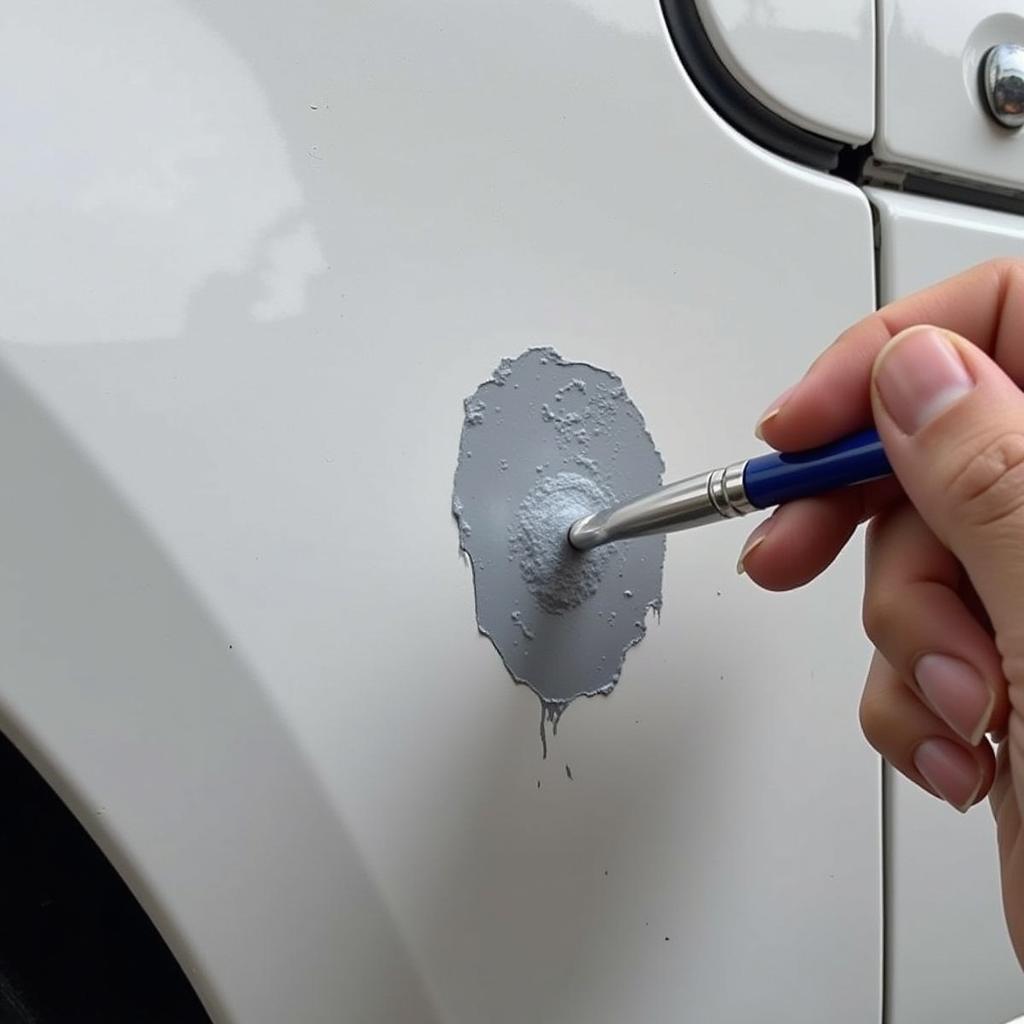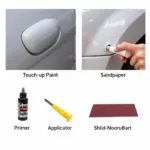Car paint chips are an unfortunate reality of car ownership. Whether it’s from rocks, road debris, or even minor accidents, these small blemishes can quickly become an eyesore and even lead to rust if left untreated. Knowing how to repair car chip paint effectively is a valuable skill that can save you money and maintain your car’s appearance. This guide provides a step-by-step approach, offering solutions for various chip sizes and severities.
Getting started with car chip paint repair involves assessing the damage and gathering the necessary supplies. For small chips, a touch-up paint pen or bottle, along with some rubbing compound and polishing wax, may suffice. Larger chips might require primer, clear coat, and fine-grit sandpaper for a more professional finish. Accurate color matching is crucial, and you can typically find your car’s paint code in the owner’s manual or on a sticker inside the driver’s side doorjamb. Remember, if you’re unsure about any step of the process, consulting a professional is always recommended. For specific services like mobile repair in your area, check out mobile car paint chip repair near me.
Assessing the Damage: How to Determine the Right Approach
Before you begin, thoroughly clean the chipped area with soap and water, then dry it completely. Examine the chip closely to determine its depth and size. This will help you choose the correct repair method. Superficial chips that only affect the clear coat are the easiest to fix, often requiring just a bit of polishing compound. Deeper chips that reach the base coat or primer require a more involved approach. For a comprehensive breakdown of costs associated with different repair types, see cost to repair paint chip on car.
If the chip has exposed bare metal, addressing it promptly is vital to prevent rust. This involves applying primer before the touch-up paint to provide a stable base and protect against corrosion. Understanding the severity of the chip is the first step to a successful repair.
Step-by-Step Guide: Repairing Minor Paint Chips
For minor chips that haven’t reached the primer, you can often achieve great results with a touch-up paint pen or bottle. Apply the paint carefully, using thin layers to avoid build-up and drips. Allow each layer to dry completely before applying the next. Once the paint has dried, use fine-grit sandpaper to level the surface and blend it with the surrounding area. Finish by applying rubbing compound and polishing wax to restore the shine and protect the repair. Looking for a DIY solution? You can find helpful resources at car paint chip repair kit autozone.
For those in the Denver area, specialized services are available; explore options at car paint chip repair denver. Remember, patience is key to achieving a seamless repair, and taking your time with each step will yield the best results.
 Applying Touch-Up Paint to a Car Paint Chip
Applying Touch-Up Paint to a Car Paint Chip
Tackling Larger and Deeper Chips: A Professional Approach
Larger, deeper chips require a more advanced technique, often involving filling the chip with primer, sanding, and applying multiple layers of touch-up paint and clear coat. This process requires patience and precision. If you’re not comfortable with this level of repair, seeking professional help is the best option. For further guidance on repairing chips yourself, you can find additional resources at how do i repair paint chip on my car.
Preventing Future Chips: Protective Measures
While some chips are unavoidable, taking preventative measures can significantly reduce their occurrence. Regular waxing provides a protective layer against minor scratches and chips. Maintaining a safe following distance, avoiding driving on gravel roads when possible, and using a car cover can also help protect your car’s paint from damage.
Conclusion: Maintaining Your Car’s Flawless Finish
Learning how to repair car chip paint is a valuable skill for any car owner. By understanding the different repair techniques and taking preventative measures, you can keep your car looking its best and avoid costly repairs down the road. Don’t let small chips diminish your car’s appearance; address them promptly and effectively for a pristine finish.
FAQ
-
How long does touch-up paint take to dry?
- Typically, touch-up paint takes about 30-60 minutes to dry to the touch.
-
Can I repair a paint chip in direct sunlight?
- No, avoid direct sunlight as it can cause the paint to dry too quickly and unevenly.
-
Do I need to apply clear coat after touch-up paint?
- Yes, applying clear coat is recommended, especially for deeper chips, to protect the repair and match the original finish.
-
What should I do if the chip has rusted?
- If rust is present, it’s essential to remove it completely before applying primer and touch-up paint.
-
Can I use nail polish to repair a car paint chip?
- While tempting, using nail polish is not recommended as it’s not formulated for automotive paint and can damage the surrounding area.
-
What if I can’t find my car’s paint code?
- If you can’t find your paint code, a dealership or automotive paint supplier can help you match the color.
-
How can I prevent rock chips on my car?
- Maintaining a safe following distance and avoiding gravel roads can help prevent rock chips.
Need more help? Check out our articles on specific car paint chip repair topics or contact us directly.
For further assistance, you can find more helpful articles on our website. For immediate support, please contact us via WhatsApp: +1(641)206-8880 or Email: [email protected]. Our customer service team is available 24/7.

